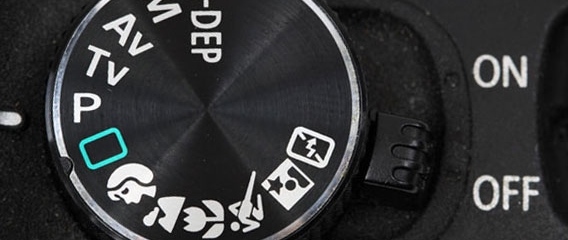10 camera settings you don’t use (and which you probably should)
Here is a list of the most overlooked DSLR settings and why these options are worth a second look.
It’s easy to fall into a pattern when you take pictures, favouring some subjects and overlooking others, and sticking to the camera settings you know rather than experimenting with those you don’t.
But here are 10 shooting options you should explore in order to get the most from your camera…
1. Manual mode
Modern metering systems are so sophisticated you might imagine exposure is far too complicated to figure out manually. Not true!
In fact it’s remarkably easy to estimate the exposure for any conditions manually – and you get to see the result on the LCD straight away, so it only takes a moment to tweak the settings and try again.
Switching to Manual mode has two big advantages:
1. You base your exposures on what you can see looks right, rather than what the camera’s exposure metering system imagines you want.
2. You can use a constant exposure for a series of shots taken in the same light, without the camera making unnecessary adjustments.
2. Daylight white balance
The camera’s auto white balance system tries to correct for different-coloured lighting to produce neutral-looking colours. Isn’t that what you want?
Not always! Sometimes it’s the colour of the light that ‘makes’ the picture, especially with landscapes, and the last thing you want is for the camera to try to ‘fix’ it.
Instead, switch your camera to the Daylight preset. This fixes the colour correction values to match regular daylight, so that any changes in the light colour are recorded faithfully, such as the cool blue light of dawn or the warm golden tones of early evening.
3. Spot metering
Your camera’s Evaluative metering system does a good job of measuring the tones across the whole image and arriving at a good, compromise exposure.
Often, though, it’s just one area of the frame that’s important, and that’s where Spot metering mode comes into its own. It measures the light across a small area only and ignores the rest.
This is often the only way to get the correct exposure with tricky subjects like spotlit performers on a stage, but it can be equally effective with everyday shots where your subject is in a different light to its surroundings.
4. Monochrome Picture Style
Picture Styles control the look of the picture saved by the camera, and almost all digital SLRs offer an equivalent.
If you’re planning on making black and white photos, the Monochrome Picture Style is especially valuable because it enables you to see how your pictures are looking as you shoot them, and how to compose them more effectively when you’re working with shapes, light and shade rather than colour.
Shoot in your camera’s RAW+JPEG mode, and you’ll have one colour image (RAW) you can work on later, and a black and white shot (JPEG) that you can share straight away. On EOS digital SLRs, you can even apply ‘contrast’ filter effects using red, yellow or orange filters.
5. Use the self-timer for tripod shots
A tripod is great for keeping the camera still during long exposures, but that’s not much help if you jog it when you press the shutter button. The ideal solution is a remote release, but what if you don’t have one with you?
Simple – you just use the self-timer instead. 10 seconds, the usual self-timer delay, is rather a long time to wait, of course – but did you know you can change the delay to a shorter time, such as 2 seconds. That’s enough for any vibration to die down, but quick enough – hopefully – to catch your subject before it moves.
6. Program shift
In program AE mode, the camera selects the shutter speed and lens aperture combination automatically. If you want to choose either setting yourself, you’re usually advised to switch to the Shutter Priority or Aperture Priority modes instead.
But there’s a quicker way – your camera’s program shift function. If you don’t like the shutter/aperture combination, you use this to shift it in favour of smaller apertures or higher speeds. On Canon EOS cameras, you do this by turning the main control dial on program AE mode – simple!
7. Auto ISO
Auto ISO isn’t just for beginners. Normally you’d set the ISO manually to suit the conditions – low ISOs for best quality, for example, and high ISOs for hand-held shooting in poor light.
But this brings the risk of camera shake, if the ISO isn’t high enough, or excess noise if you’ve set it higher than it needs to be. This happens all too easily if you’re shooting in changing conditions and don’t have time to alter the settings.
This is where auto ISO comes into its own – the camera will use the lowest suitable ISO for the conditions and only increase it where necessary to avoid camera shake. You can usually set the maximum ISO you want the camera to use, if you’re concerned about quality.
8. AE lock button
On most cameras you can half-press the shutter button to lock the exposure, so that you can re-frame the shot and take the picture without the exposure changing. However, this also locks the focus, which isn’t always desirable.
So use the AE lock button on the back of the camera instead. This locks the exposure only. You can release the shutter button as you reframe the shot, then press it again when you’re ready to take the picture. The camera will re-focus on your subject, but keep the exposure you ‘locked’ – perfect for spot metering.
9. Focus in Live View
If you’re composing close-ups or still-life shots with the camera on a tripod, use Live View to focus – you can move the focus point anywhere in the frame and zoom in to check the fine detail, which makes it especially effective for manual focusing.
10. Long exposures
Photography isn’t just about freezing moments in time. Try using longer shutter speeds of a second or more to see how movement blur can enhance your pictures. Obvious subjects include waterfalls and seascapes, try recording fields of corn swaying in the breeze or pedestrians passing in busy streets.
Have a great shoot!





















Great Article. I struggling with my new camera when I take it of AUTO, but I’m not giving up. Thanks for posting this, and I’m looking forward to reading more.